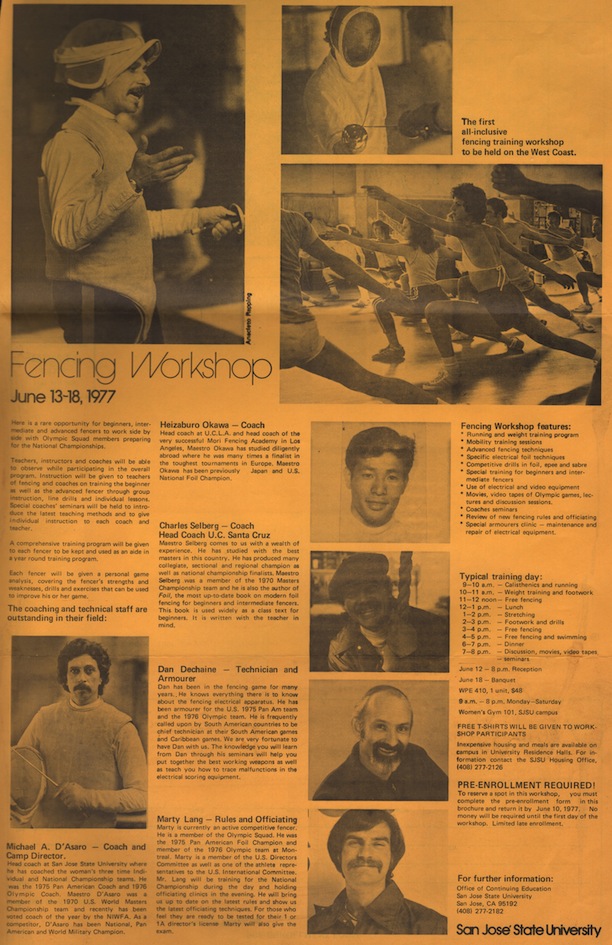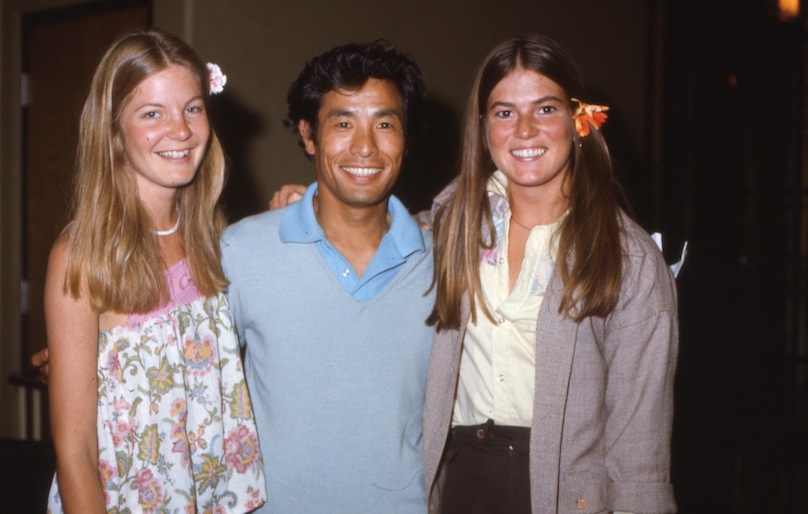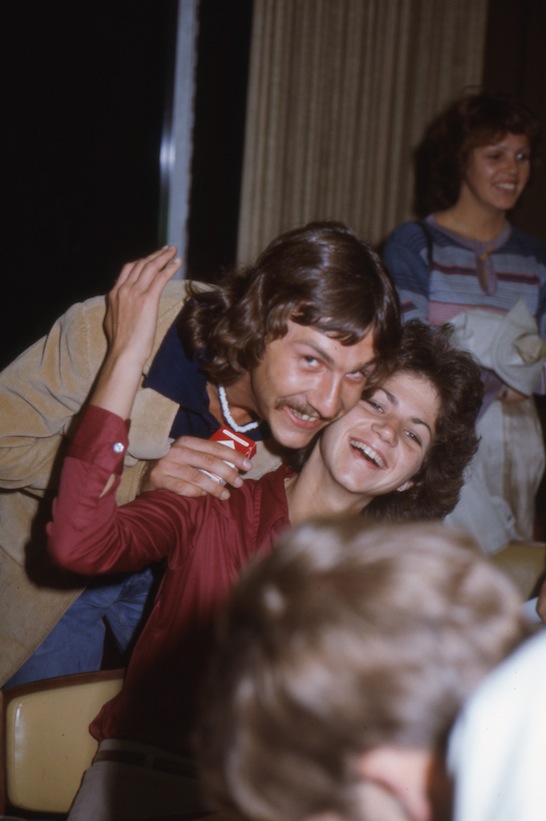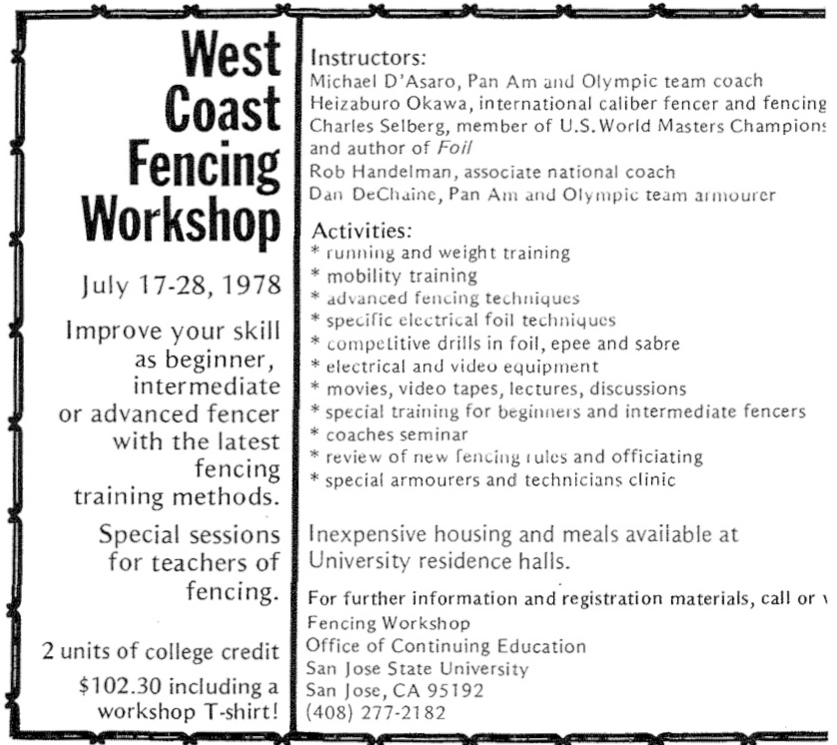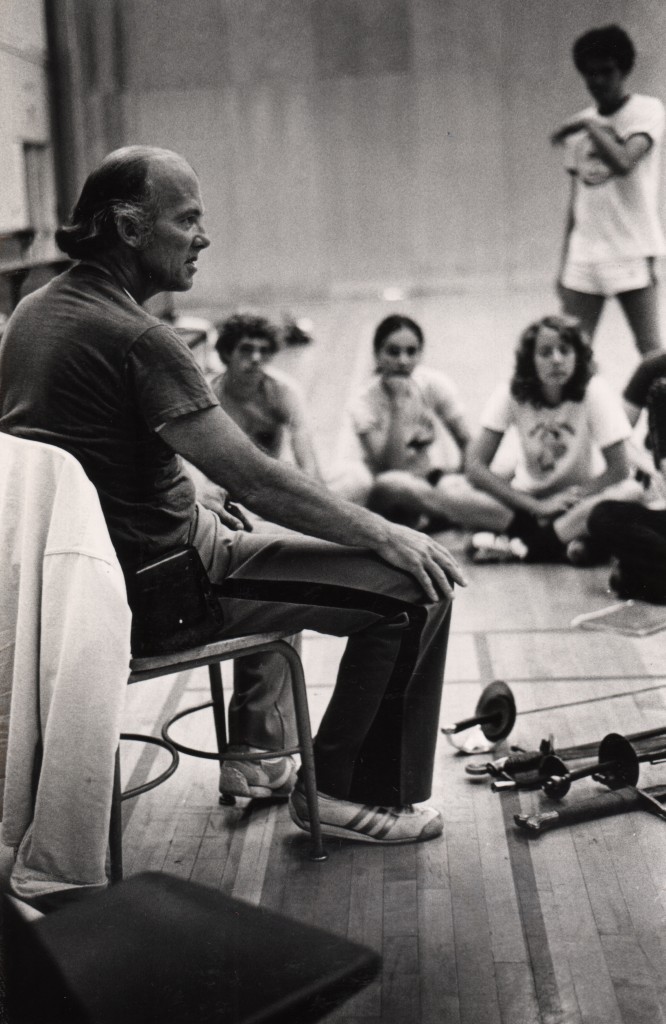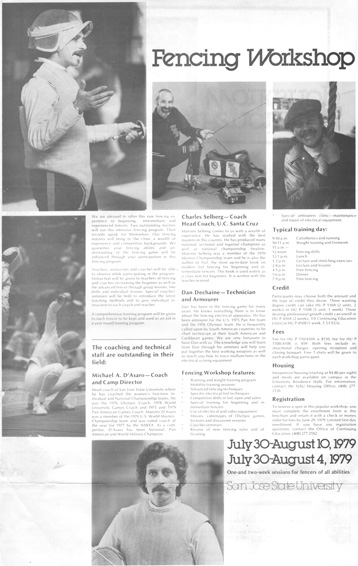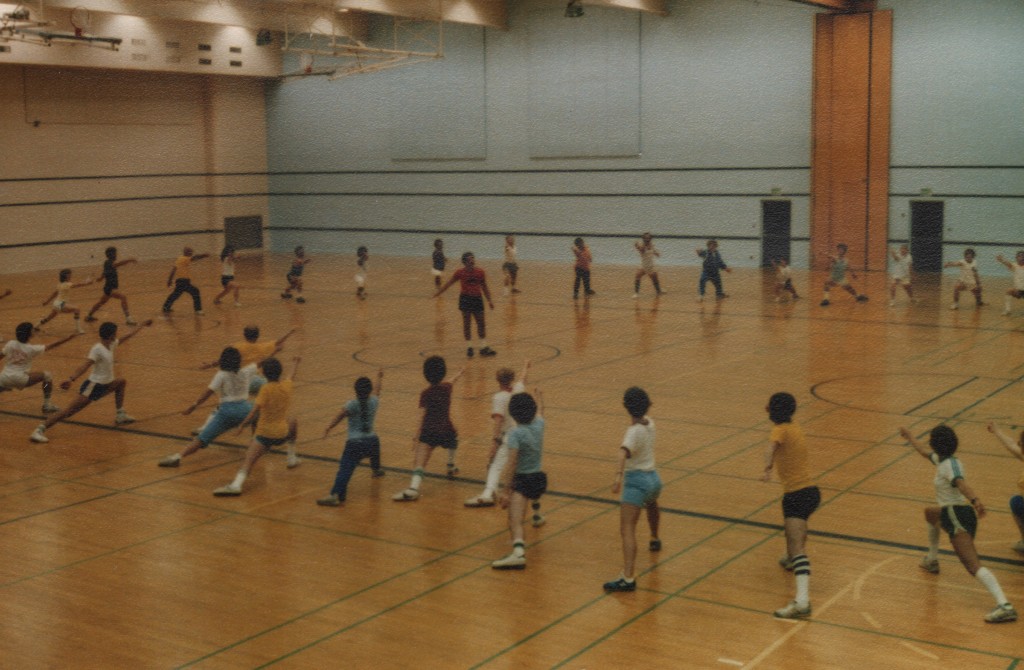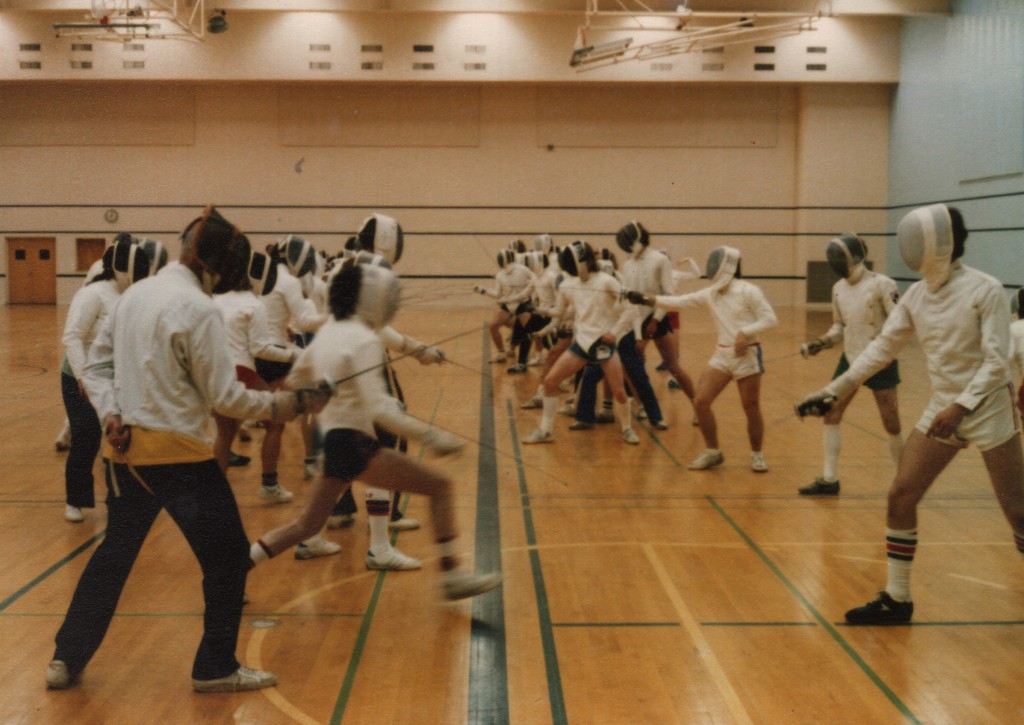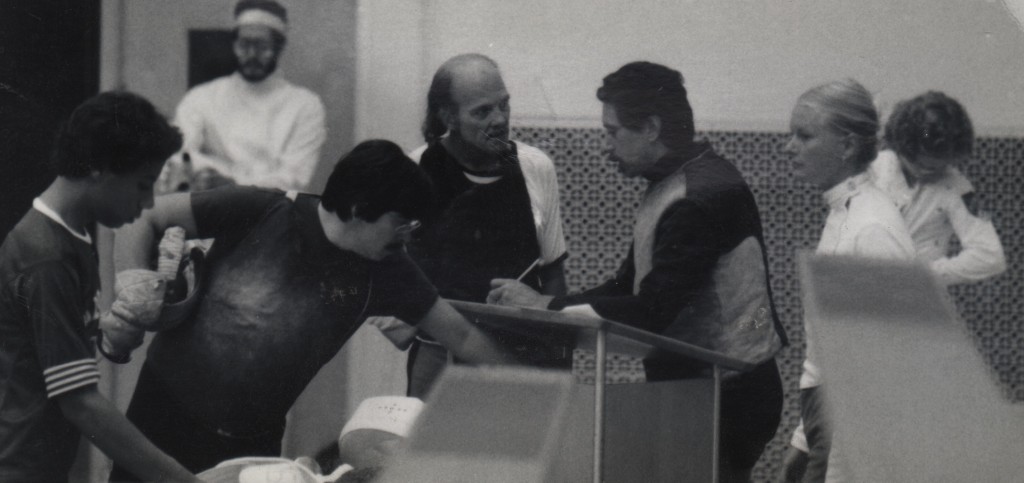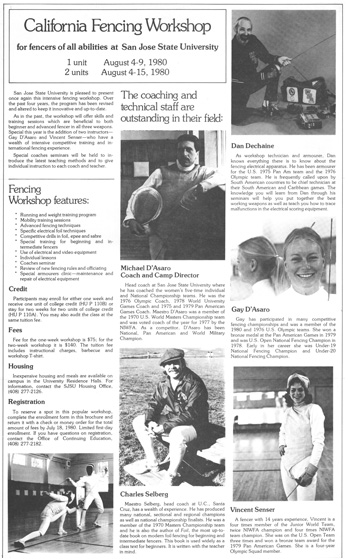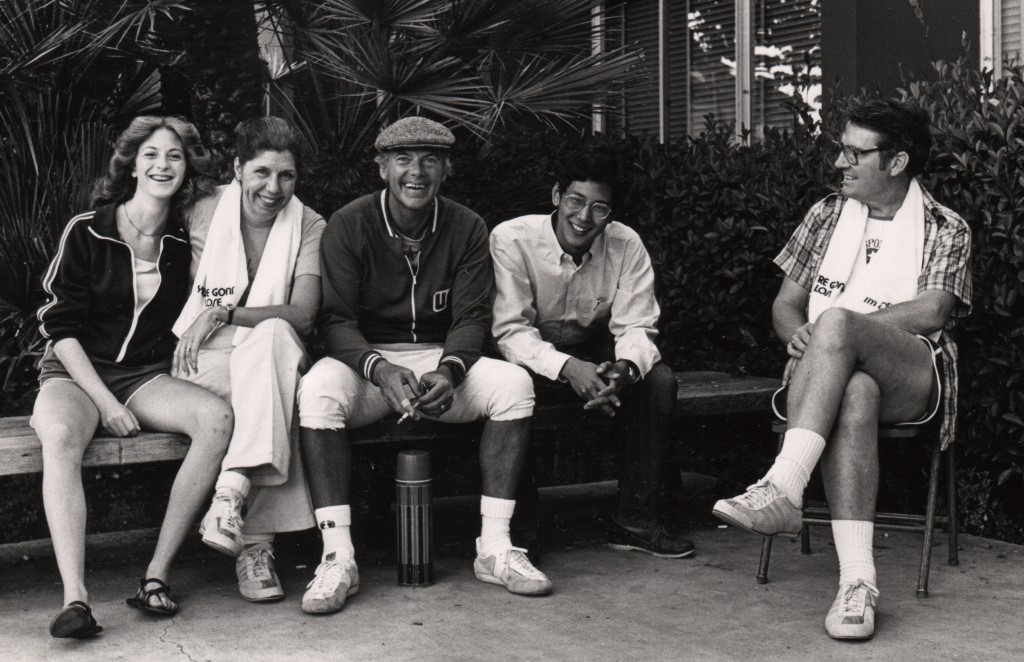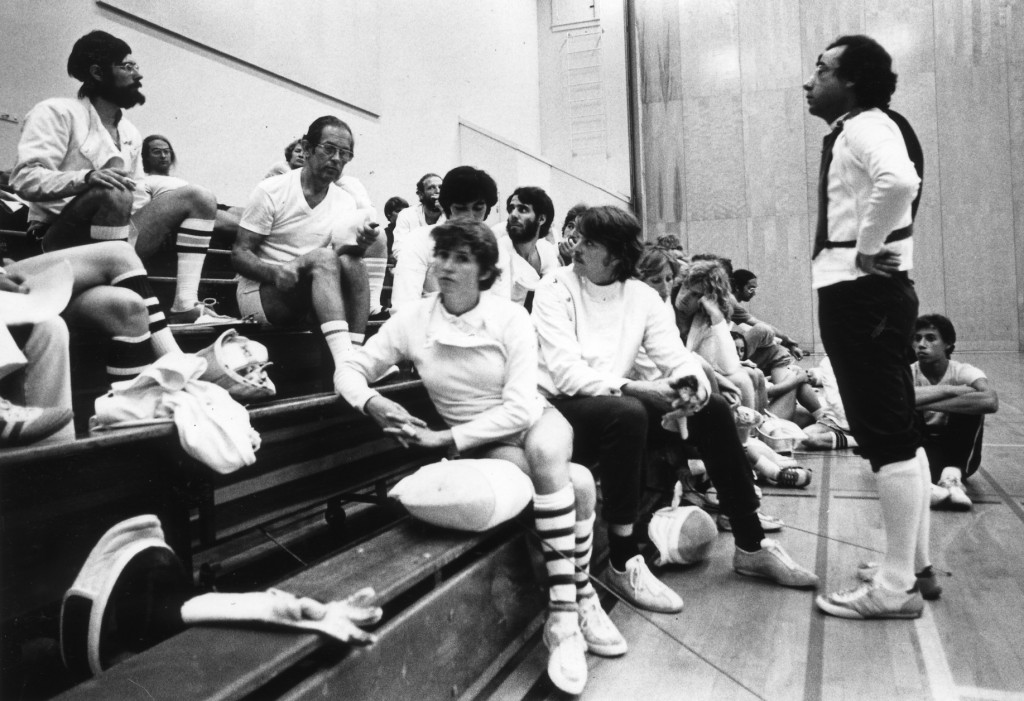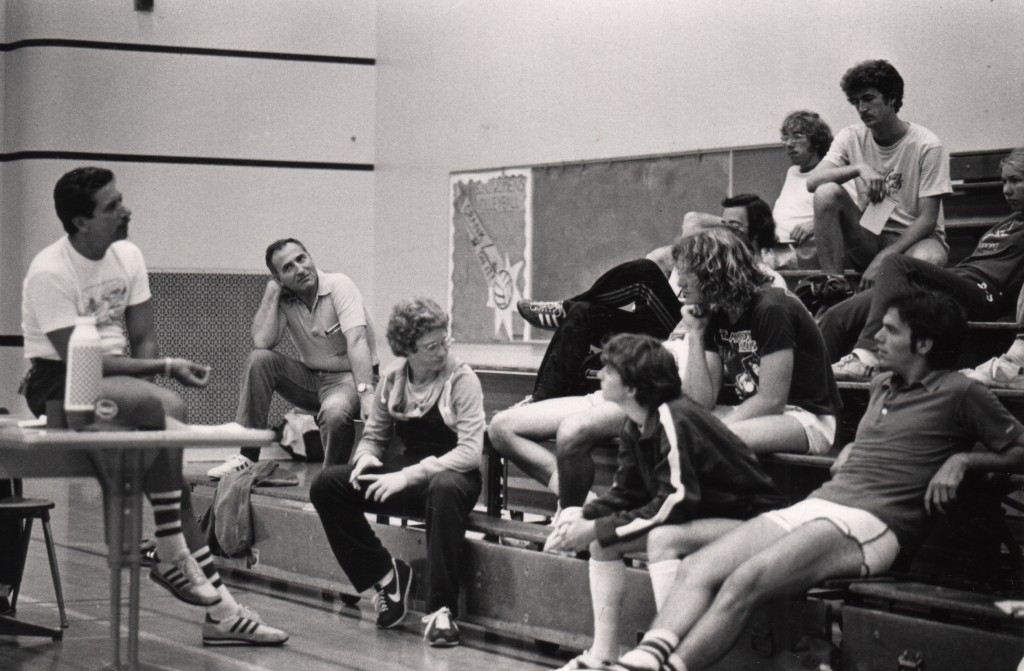Ah, San Jose, California in the summer. In the late 70’s, that meant two things: heat and smog. However, for a few years it also meant fencing at the University!
Sometime prior to the summer of 1977, Michael D’Asaro and Charles Selberg devised a plan to create a summer workshop for fencers. Both were instructors at Universities, San Jose State and UC Santa Cruz, respectively, but San Jose was closer to an airport of decent size and I suspect that’s why they settled on the Home of the Spartans over the Land o’ Banana Slugs as a location for a summer fencing workshop. Landing at the Scotts Valley Airport was only for the smallest of twin-engine planes and dicey in the best of conditions. It’s closed now. The San Jose airport is International now. Much easier.
The handbill advertising the first Summer Workshop, June of 1977.
The first year had a stellar crew. Besides Michael & Charlie, they had Heizaburo Okawa, the ever-popular Dan DeChaine, and 1975 Pan Am Champion Martin Lang (who won Men’s Foil Nationals in ’78). Those were just the attendees who made the pamphlet. In perusing the Charles Selberg Scrapbooks, I’ve spotted a number of photos related to these various camps – they went on through 1980. (Full disclosure: I attended the 1978 and 1979 versions. Evidence to follow.) For the 1977 camp, there are some fairly innocuous party photos that I hope no one will take objection to me sharing here. I guess I’ll find out.
Charlie Selberg, Michael D’Asaro and Heizaburo Okawa, all dressed in party finery!
Stacey Johnson and Hope Konecny, also in party finery, flanking Heizaburo.
Hey, it was a party, ok? That’s Australian Olympian Greg Benko on the left.
The most oft-told story I’ve heard about this workshop, and maybe someone who was there can chime in and add some factual content to the tale, was that on the final day, there was a fence off between some of the best fencers. Or maybe it was a round robin pool. Or a challenge match. I don’t know. I’ve heard all three versions. But the commonality between the tellings is that the last bout was between Heizaburo Okawa and Greg Benko. A little background. Greg Benko, an Australian Olympian, made the finals at the 1976 Olympics, placing 6th. He would have been about 25 years old. Okawa had retired from competition in 1968 and was 38. The way I’ve heard the story, Benko expected that he’d have to be nice to the old guy, quickly learned different and tried to adjust. Allegedly, Okawa took him apart. That’s the way I heard it.
The 1978 version of an ad, run in American Fencing magazine. I cribbed the image from a scan done by others, so I apologize for the lopped off text on the right side.
The first workshop was successful enough to warrant another in 1978. Interestingly, the dates for the two-week workshop were moved to later in the summer, compared to the first go-round. I believe this was done so that the event would be less of a ‘let’s get ready for Nationals!’ excursion and more of a ‘let’s learn all about fencing!’ event.
Charlie giving his interesting and effective lecture on the “History of the Sword”, which usually included an opportunity for some lucky adventurer to stand at the receiving end of a very sharp dueling sword. The lucky one was promised riches untold during a right-of-way discussion if they would choose to ignore self-preservation and launch themselves onto the point.
Michael takes the floor to discuss footwork.
It’s funny how the memory works. I’d always had it in mind that I had attended two of these workshops, but it took OJ Simpson to revive the details. My lasting memory of this camp in 1978 (sorry ‘Stro, sorry Charlie,) was that we were sharing the San Jose State dormitory with not just the other fencers, but also with the San Francisco 49er’s. They were in training camp. I mention OJ because 1978 was his first of two seasons with the Niners, and we saw him daily, going in and out of the dorm or dining hall. Whatever horrors he perpetrated later, OJ playing for the 49er’s in 1978 was big news at the time. (Simpson grew up in San Francisco’s Potrero Hill neighborhood and was well known in local lore as a street thug. Behind the TV persona, there must have always been the temptation to revert to type. Temptation realized.) What helped me remember that I attended this particular year is tracking down a link listing 1978 as the last year the Niners had their training camp at SJSU. I love the internet. So, I was there. I fenced. Others fenced. That’s all I remember.
Year three.
I have fond (and more powerful) memories of this two-week excursion. It was a terrific group of people and we worked very hard. I had also made the decision to attend San Jose State the following year so that I could train with D’Asaro and the San Jose crew. I was a local product, transferring in from Cabrillo Community College in Aptos, where I’d been coached by Len Carnighan, who Michael knew well. Michael watched me pretty close during the two weeks, just as he watched another incoming transfer, Clay Fingerman. Clay was a New Orleans sabre fencer coached by Eugene Hamori. As soon-to-be-Spartans, we pushed each other daily to improve our games.
A circular footwork drill around Michael D’Asaro.
I’m visible in this shot, but I’ll leave it to you to guess which pair of legs revealed by those then-stylish shorty gym shorts belonged to me.
The five across the front of this photo, where Mike & Charlie are plotting the next tortuous drill are: Michael Jr. (who was still in high school) Len, Charlie, Mike & Gay. I can’t remember the names of the two fencers in back, but I recognize their faces, as I fenced with them for 2 weeks.
The last day of the camp is one that I can’t ever forget. Michael and Charlie announced as the day began that we’d be fencing all day, and the two of them would work to make sure all the participants got at least one individual lesson. I ended up getting two, one from each of them, and the experiences couldn’t have been more disparate. Did they plan it? I don’t think so; it was just how each worked. My first lesson was with Charlie. What a positive experience! I couldn’t do anything wrong! He was all compliments and praise, so excited by the expertise shown by a mere two-year fencer. How could I possibly be so good? I was a miracle of biblical proportions! Hooray! Thank you, Maestro!
Not 5 minutes after completing the lesson with Charlie, I hear Michael from across the room. “Doug! You’re up!” he shouted.
I did infer the experiences were different, didn’t I? Well, good. Because I thought Michael was going to kill me. At one point I thought he might start beating me over the head with his mask. As opposed to my lesson with Charlie where I could do no wrong, with Michael, I could do nothing right. I moved around too much. My disengages were too big. “Keep your hand here. Not here. Here. Stand still. Now, move! What was that? That was shit! “ I’ve never been initiated into a street gang, but I think I know what it must be like. Now, Michael knew I was coming to San Jose that fall, so I think he just wanted to find out what I was made of. I think he discovered that I was made out of jello. Or pudding. Something melty with no ability. His berating got louder. And louder. By the end, I was relatively useless. When we finally finished, we took off masks and saluted. I must have looked like I’d seen a ghost. I was either pale and fainting or red-faced with shock and embarrassment. Whichever it was, Michael laughed, gave me a one armed hug around my shoulders and said, “Awright! Good work!”
I left the room, found a quiet corner and completely broke down, certain I’d never be worth anything as a fencer.
Now, you may be thinking that this was a terrible way to treat me. And it was. I certainly never forgot that lesson. But it helps me put certain things about Michael into perspective regarding his own growth as a coach. At this time of his career, he was certainly tough on his fencers, physically and mentally. He could ride you like you hear about on ESPN when they talk about tough coaches. There was an interesting incident at San Jose when I was in school there. The Men’s Basketball team was essentially feuding with the coach, as he was a hard-nose, tough, verbally abusive personality. One afternoon, a few of us fencers went down to watch basketball practice, to see what all the fuss was about. It was a tough session, and there was certainly some yelling. But comparatively? Michael was way tougher, and he held a sword in his hand that he wasn’t afraid to use to get an idea across. He wasn’t a brute, but he was tough, had exceptionally high standards and we often didn’t come up to scratch. And he would let us know.
Now, fast forward to the early 90’s. Michael had moved to Los Angeles and was teaching at the Westside Fencing Center. I was working down in Hollywood and picked up with lessons with Michael off and on from 1991 until he stopped teaching around 1999, just prior to his passing. And there, I discovered a very, very different Michael. No longer the yelling, the force, the put-downs. No “Mama-Mia!” exclamations. The LA Michael was a kinder, gentler, more positive version. The same skill, the same technical perfection and expectation of performance, but without the price his earlier persona could exact from your psyche. He talked about it with me, as I was curious what wrought the change. He explained that he had come to the realization that the yelling and abuse didn’t achieve a higher level of performance from his students. It might have made him feel better back in the day, to release his own frustrations at our sometimes distracted or just plain poor performance. But it wasn’t helping the student. So he changed up his approach. It completely changed the experience of the lesson, not because back in the day I might approach a lesson with trepidation – it didn’t work that way. It was more about the aftermath. If a lesson went south, it was hard to remember the positive work you may have done. But in LA, a tough lesson performance could be discussed without guilt or rancor, and both of us could look forward to the next meeting to create a better experience.
Michael was a complex person, no doubt. I’m glad I got to experience both sides of that coin.
The 1980 edition. This was the last one they held. At this point in time, Charlie was starting to lean towards the exit at UC Santa Cruz and by the following summer I believe he was actively looking for a new home.
I didn’t attend this one, but a lot of San Jose and Santa Cruz folks did. It was probably a good time.

Michael with friends…
… and Charlie with friends.
John McDougall helping out with a lecture and demonstration.
Michael talking about fencing, or just having a chat about where to have lunch?
The four years of these camps certainly seemed to have been a success in all manner of ways. The number of participants made it worthwhile and I know from personal experience that the contrast between Michael and Charlie made for a unique atmosphere that really opened up learning about the sport along multiple lines of thought. That, plus the casual fun that both could bring to a day of strenuous activity. As Len Carnighan might say, “It was better than a good time.”
The smog is greatly lessened in the Santa Clara Valley these days. If you live in a pollution free area and can’t appreciate the realities of growing up in a smog filled valley, let me just say that catalytic converters and curbs on industrial air pollutants have made a significantly positive impact in what is locally known as the South Bay. Drive down today from the Santa Cruz mountains into the Home of the Silicon Chip during the hot, still, summer and you’ll seldom witness the brown layer of smog rising half-way up the hillside surrounding the valley. You had to hold your breath and steel yourself to drive down into it. In those days of yore, it was like putting your head under a dirty blanket that you would really prefer to not have to touch– and then having to breathe through it. Hey, that’s what we lived with. Now? Not so much.
What’s that? Humans can’t possibly impact global climate? I beg to differ.


